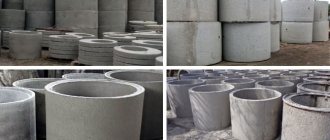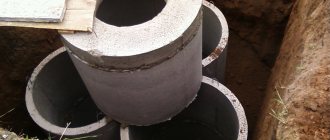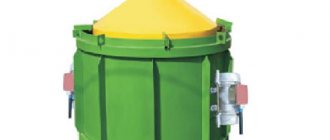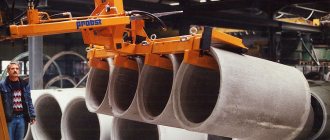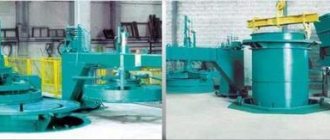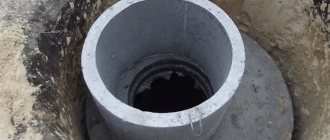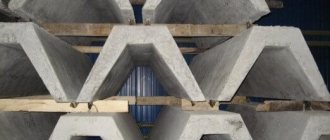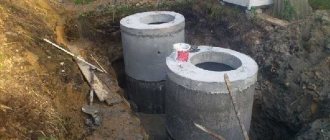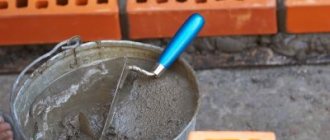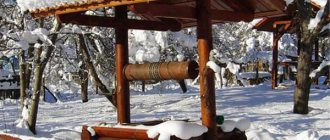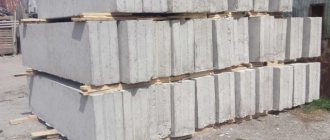Decoding the letter markings of the rings
They are used quite widely and not only in the construction of drinking wells or sewerage basins. The products are used in the construction of columns, inspection pits (in places where pipelines are routed), settling tanks, and various tanks. Concrete concrete rings are:
KS: through or wall. It looks like a concrete cylinder. If several pieces are placed on top of each other, you get a whole column, the height of which depends on the depth of the well. The diameter of such rings is in the range of 0.7-2 m with a wall thickness of 5-10 cm. Products are standard, with smooth ends or equipped with a locking protrusion for ease and reliability of installation. You can also find rings with thicker walls for use in deep wells.
PC: through, differing from the previous ones by the presence of a cover at the end.
KCD: with bottom. The configuration resembles a glass. Such rings are in demand when assembling septic tanks, settling tanks and sewer systems, where the tightness of the container is required to prevent harmful substances from penetrating into the soil. The presence of a bottom speeds up installation, since there is no need to fill the bottom with concrete.
KLK: for storm drainage.
KO: supporting. They are installed at the very bottom of the well column, characterized by their small height and thick walls.
CPK: fecal. Used in the installation of domestic sewage systems.
KVG: observation rooms. They are used to control gas and water mains.
Concept of reinforced concrete products
Precast concrete products are products that consist of two main components:
- concrete;
- steel reinforcement.
The combination of these two components creates a very strong material called reinforced concrete. To obtain products with certain characteristics, different types of concrete can be used.
After the product cools, it begins to withstand loads well, and with the constant compaction that occurs during this process, the structure becomes even more durable.
The reinforcement used in the formation of reinforced concrete products is quite durable and can withstand significant tensile forces. The combination of these substances creates a truly unique material.
Letter marking of plates for rings
Flat reinforced concrete products are laid at the bottom of the well or arranged at the top. Their use significantly speeds up installation work, since pouring concrete is not required. The slabs are:
PN: grassroots. The shape resembles a pancake, which is placed at the bottom of the pit.
Software: supporting. These are rectangular slabs with a central hole that cover the well on top.
PD: road. Reminiscent of the product described above, but has greater thickness. The slabs are laid on the top ring of the well column if it is on the roadway.
PP: for floors. The products are similar to PN, only unlike them they have a hole shifted to the side from the center.
Requirements for materials and raw materials
Reinforced concrete sleepers Sh1, according to GOST 26633, are made of heavy concrete with a strength of B40 or more. In general, everything that is used during production must comply with the same interstate standard.
The required strength (both tempering and transfer strength) is established separately for each type of reinforced concrete products, in accordance with GOST R 53231 and taking into account the selected structure and reinforcement. But it is important that it is not less than 349 kgf/cm2.
For reinforcement the following can be used:
- Periodic or plain wire, if made from B1200 steel (or better), has a diameter of 3-8 mm and is cold-worked; or if it is 8-10 mm in cross-section, and its strength is 1400K.
- Rods, thermomechanically reinforced and hot-rolled, no narrower than 8-10 mm, with a minimum resistance rating of A1200K.
- Metal ropes 6-14 mm in cross-section, class K1500K or better.
No matter how the Sh1 sleeper is strengthened, the passport and accompanying technical documentation must contain information about the location and quantity, diameter and strength of the reinforcing elements, as well as the effective tension values. Any other options are possible only with prior agreement of this point with the customer.
Concrete of sufficient frost resistance should be used - at least F200.
When casting, it is important to ensure that the reinforcement rods and rods do not protrude beyond the ends of the reinforced concrete products; wire can, but 20 mm, no more.
The parameters of embedded parts largely depend on the chosen design and therefore must be reflected in detail in the technical documentation.
Size markings and weight
The designation of dimensions in decimeters follows immediately after the letters. For example, KS 7.3. The internal diameter of the ring is indicated here - 7 dm - 70 cm and its height is 3 dm - 30 cm. It is worth noting that according to GOST, the standard size will in reality be 1 cm smaller, i.e. 29 cm. Rounding is done for convenience. The mass of the ring is not indicated: each manufacturer has its own and depends on the brand of cement, type of filler, amount of reinforcement, and wall thickness. For example, a KS 7.3 ring weighs on average 0.13 tons, and a KS 20.9 ring weighs 1.47 tons on average.
Explanation of product labeling
Let’s say you know what dimensions in theory and how much the reinforced concrete sleepers Sh1 and Sh3 weigh, but the difference between them is not only in dimensions (which cannot always be seen visually), but also in the designation printed on the surface of the support. This is an article consisting of letters and numbers, and from it you can already understand what the concrete products are.
This is what the symbols say in our case:
- Ш – actually, sleeper;
- 1 – with BPU-fastening, that is, with a separate terminal-bolt connection;
- 1 – execution index, explaining the geometry of the site.
The products in question are marked in two stages: the first is carried out immediately after pouring the solution into the mold (even before it hardens) - by stamping, the second - based on the results of the quality control department. Units of the batch that have passed inspection receive a seal affixed with indelible paint (grade I) or a transverse stripe near the end (grade II).
Marking concrete and products made from it: learning to read symbols
After a working day, the man decided to rest: a homeless guest was waiting for him in bed. I achieve toned legs with just one exercise in 15 minutes. Thieves stole the old man's bag, but inside there was not money, but something frightening. Home Home comfort Construction.
Purpose Lintels are reinforced concrete beams that rest on the masonry walls and transfer to them the load of the masonry and floors overlying the opening. Sergey Al November 21, Comments 0. New Discussed Popular.
Types of concrete concrete markings
I want to receive. New comments to your personal account. Replies to my comments. Read online - Follow new comments - 8. Cancel Reply. Editing a comment is possible within five minutes after it is created, or until a response to this comment appears.
Cancel Save. Unsolicited advertising or spam. Materials of a sexual or pornographic nature. Child pornography. Drug propaganda. Violence, self-harm. Account hacking. KLK - products intended for the installation of drains and urban storm sewers. KVG - rings used for installation of gas pipelines and water wells. In addition, the ring markings also contain numerical designations. Example of decoding: KS This means a wall ring with a wall thickness of 70 and a height of mm.
Concrete rings are available in a very diverse range of sizes. Standard product sizes look like this:. Thanks to these standard sizes, choosing rings for arranging an individual water supply system is not difficult.
It should be noted that installing rings alone will not solve the problem of a high-quality water supply system. In order for the well to meet the requirements, the installation of additional elements will be required. This is not a mandatory condition, but compliance with this rule will help prevent contamination of the system with wastewater, increase its service life, and give the structure a complete look.
Floor slabs - thanks to a narrow hole on top of such a slab, a ring of small diameter is installed, closed with a regular manhole cover.
Deciphering the markings of concrete, as well as products based on it, is very important for those who are planning construction on their own. In our article we will provide information about the most common designations, as well as a number of tips on the use of certain materials. Both of these indicators are interdependent and therefore can be used in parallel.
Additional rings are products of standard diameter, but smaller thickness. Such elements help raise the height of the well to the desired level. The use of such products ensures maximum tightness of the well and prevents pipes from freezing in winter.
In order for the well to meet the established requirements, the installation of the structure must be carried out in accordance with all the rules.
see also
Here you need to follow the well-known procedure:. Water wells and drainage systems are not located close to residential buildings.
The average distance from the house is about 5 meters. There should be no groundwater in the chosen location, otherwise you will have to incur additional costs for sealing.
In addition, special equipment must be freely accessible to the installation site. To dig a pit, it is better to hire equipment: the depth of the hole should be equal to the height of two rings. Digging such a pit by hand will be very problematic. A drainage cushion made of layers of sand and crushed stone, at least 50 cm thick, is laid at the bottom of the pit.
For the lower tier, a ring with a solid bottom is ideal; if the product is through, the bottom slab is laid first. The elements are installed on top of each other using a truck crane, the joint is covered with mortar. Installation signs are pictograms that indicate places for installation of reinforced concrete products.
This is the place of slinging, places of support, center of gravity if necessary, risks during installation, designations of the top of the structure, etc. This concept includes digital and alphabetic designations, which are divided into three groups: Product type.
Class of reinforcement, type of concrete, load-bearing capacity of reinforced concrete products. Special properties of the product. As you can see, when marking reinforced concrete products, measures such as decimeters and, in the case of mass or design load, tons are used. Methods of marking In accordance with the requirements of GOST, marking of reinforced concrete structures cannot be applied to areas that are supposed to be subsequently finished or painted.
GOST General technical requirements. Rules for acceptance, labeling, transportation and storage. The Eurasian Council for Standardization, Metrology and Certification EASC is a regional association of national standardization bodies of the states that are members of the Commonwealth of Independent States.
Therefore, modern industry is focused on increasing their production volumes. Production of reinforced concrete products. Varieties of reinforced concrete products by type of reinforcement were discussed in the previous section. Depending on the volumetric weight of concrete, all reinforced concrete products are classified into:. Note that the concrete solution used for concreting factory-produced structures differs from conventional ready-mixed concrete in the smaller fraction of crushed stone mm, which ensures uniform filling of the casting mold.
The range of reinforced concrete products includes more than 20 different items; let’s consider the symbols of the main ones:. Types of reinforced concrete products. According to their functional purpose, concrete and reinforced concrete structures are divided into 4 main groups: The group of reinforced concrete products for the construction of residential buildings includes floor slabs, piles, wall panels, foundation blocks, trays, lintels and beams.
The most common types of concrete products
Among all the products produced by the manufacturer, the following types are in greatest demand:
- Their. They are necessary when creating the foundation of industrial and residential buildings. The choice of type and method of installation depends on the strength of the soil, climatic zone and other factors;
- Columns. They are needed to transfer the load from the upper floors to the base or surface;
- Trays. Such an element is used in the process of laying channels located inside or outside the building;
- Floor and road slabs. The former are used in the construction of residential and industrial structures, the latter - for the creation of roads, temporary and permanent airfields, etc.;
- Well rings. With their help, wells are created, inside which cables are laid;
- Fence. A fence created from such elements will provide protection from prying eyes and the entry of unwanted guests.
How do iron and concrete complement each other?
The bottom line is that iron, if water gets on it, begins to oxidize (destroy). Concrete, on the other hand, is a very durable material. But its strength continues until bending load occurs.
Concrete works well solely in compression. For this reason, combining iron reinforcement and concrete makes it possible to neutralize the disadvantages of each material separately and enhance the advantages.
For example, concrete can effectively protect reinforcement from moisture that is inside it (if special additives were used). The reinforcement guarantees the bending function of building parts.
In addition to cement and iron, other components (so-called fillers) are also used in reinforced concrete products. Depending on the purposes and tasks for which the use of reinforced concrete products is planned, the latter use certain fillers (sand, crushed stone, clay, etc.).
Do not forget that the reaction of cement and water is not carried out chemically. Therefore, the iron cannot be damaged in any way.
Explanation of jumper marking abbreviations
The abbreviated name of the reinforced concrete lintel from the manufacturer is marked with a special code consisting of numbers and letters. For a deeper understanding of the properties of each product, it is necessary to understand the code sequence.
Let's consider an example of the 9PB 13 -37-p brand:
- 9 – jumper profile;
- PB - execution of the jumper in the form of a bar;
- 13 – the number corresponds to the length in decimeters, rounded up, the actual length is 1290 mm;
- 37 – calculated load, dead weight taken into account, full figure 37.27 kN/m;
- p – use of mounting loops in the design.
The code may also contain the letter “a” - which means the use of anchor outlets to secure the balcony block slab. Example, 10PB 21-27-ap.
When manufacturing reinforced concrete lintels from the manufacturer, in accordance with GOST 948-84, heavy concrete (grade M200) is used for increased strength and wear resistance. In products whose width is 120 mm, flat frames are used as reinforcement. In a lintel with a width of 250 mm, the assembly during manufacturing is carried out with spatial frames made of iron reinforcement.
Properties of concrete products
- high fire resistance;
- increased compressive, flexural and tensile strength;
- excellent sound insulation;
- seismic resistance;
- crack resistance;
- exact dimensions and correct geometric shapes;
- ease of installation when using special equipment;
- affordable price.
